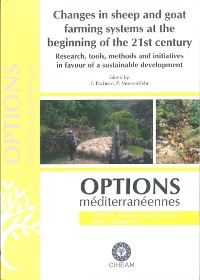| Article précédent | p. 253-256 | Article suivant |
Organic and conventional dairy goat production systems in Andalusian mountainous areas
Organic goat production is poorly developed in Spain. Conventional dairy goat production systems located in Andalusian mountainous areas greatly depend on pasturing which implies that its transformation to organic model is not difficult. The objective of this paper is to evaluate the viability of organic dairy goat farms -as compared to conventional-, and to study the possibilities of transitioning from conventional to organic goat production. This study was carried out in 2006 in Sierra de Cádiz (Andalusia) with the autochthonous breed Payoya. To monitor technico-economic aspects of goat farms, FAO-CIHEAM method was implemented. Results indicate that organic farms are economically viable, due mainly to low costs of external feeds and income from European Union subsidies. For transitioning from conventional to organic dairy goat production a reduction of consumption of concentrates per animal and per year and/or cultivate grain on the farm are necessary.
La production caprine biologique est encore peu développée en Espagne. Les systèmes caprins laitiers dans les zones montagneuses de l'Andalousie disposent de grandes surfaces de pâturage qu'il est, par conséquent, assez facile de transformer en systèmes biologiques. L'objectif de ce travail est d'évaluer la viabilité des systèmes caprins biologiques par rapport aux systèmes conventionnels et d'étudier les possibilités de conversion des systèmes conventionnels en systèmes biologiques. L'étude a été réalisée en 2006 dans la Sierra de Cádiz (Andalousie) avec une race autochtone (Payoya). La méthodologie FAO-CIHEAM a été utilisée pour le suivi technico-économique des exploitations caprines. Les résultats montrent que les systèmes biologiques sont économiquement viables compte tenu surtout des moindres coûts alimentaires par rapport aux systèmes conventionnels et des aides de l'Union Européenne. Pour réussir la transformation des systèmes laitiers caprins conventionnels en systèmes biologiques, il faut réduire l'apport de concentrés et essayer de les produire dans l'exploitation.
- [ Afficher ]
- [ Télécharger ]
- [ Exporter la citation ]
Vous pouvez télécharger la citation au format :
- [ Imprimer ]
-
Mots-clés
AGRICULTURE BIOLOGIQUE, ANIMAL LAITIER, CAPRIN, ESPAGNE, INDICATEUR, REGION D'ALTITUDE, SYSTEME D'EXPLOITATION AGRICOLE, VIABILITE ECONOMIQUECiter cet article
Mena Y., Ligero M., Ruíz F.A., Nahed J., Castel J.M., Acosta J.M., Guzmán J.L. Organic and conventional dairy goat production systems in Andalusian mountainous areas. In : Pacheco F. (ed.), Morand-Fehr P. (ed.). Changes in sheep and goat farming systems at the beginning of the 21st century : research, tools, methods and initiatives in favour of a sustainable development . Zaragoza : CIHEAM / DRAP-Norte / FAO, 2009. p. 253-256. (Options Méditerranéennes : Série A. Séminaires Méditerranéens; n. 91). Proceedings of the Seminar of the Subnetwork on Production Systems of the FAO-CIHEAM Network for Research and Development in Sheep and Goats, 2007/11/15-17, Ponte de Lima (Portugal). http://om.ciheam.org/om/pdf/a91/00801156.pdf



